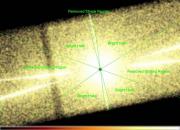Interstellar Dust
The compositional make-up of interstellar (ISM) dust and the relative abundances of chemical elements in astrophysical environments are not well understood. Since dust is a primary repository of the ISM, and is responsible for the chemical evolution of stars, planets, and life itself, it has a profound effect on many areas of astrophysical research from cosmology to star and planet formation. Powerful X-ray satellites (Chandra, XMM-Newton, Suzaku) pointed through dust at bright black hole (BH) and neutron star (NS) systems can be used to study ISM dust in unique ways
X-ray dust scattering halos can be found surrounding many bright BH and NS systems with dusty lines-of-sight. Using knowledge that X-ray halo properties tightly depend on the size distribution of the dust grains and the relative distance of the scattering by the dust grains, we can use geometry arguments to study halo profiles and distinguish the location of dust clouds close to the X-ray system (sharp, narrow halos) against those close to us (flat, wide halos), and determine their distribution. For some X-ray binary systems, we can measure scattering delay times to determine distance to the BH/NS system itself.
We have begun a campaign to directly probe ISM dust composition by combining space based high spectral resolution Chandra HETGS X-ray measurements with laboratory synchrotron experiments at the ALS of X-ray absorption fine structure. Combined with infared Spitzer studies, we can begin to address such questions as: What is the mineralogy of ISM dust -- is it crystalline or amorphous? Is there thermally emitting dust in/near X-ray emitting systems -- what of their properties?
Julia C. Lee




